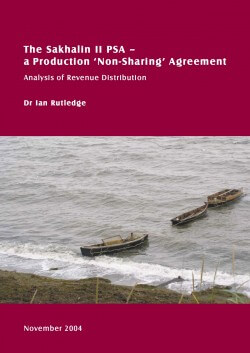 “It is surprising that the Russian Party agreed to these terms […] Given this outcome of the PSA it would be better to describe it as a ‘Production Non-Sharing Agreement’.” Ian Routledge, energy economist
“It is surprising that the Russian Party agreed to these terms […] Given this outcome of the PSA it would be better to describe it as a ‘Production Non-Sharing Agreement’.” Ian Routledge, energy economist
Platform’s report “The Sakhalin II PSA – a Production ‘Non-Sharing’ Agreement” reveals that revenue distribution for Sakhalin II between the Russian government and Shell’s consortium (SEIC) is set at a grossly unfair level. The contract terms, defined in a 1994 Production Sharing Agreement (PSA), place the Russian state at a significant disadvantage.
Download the report (pdf).
Russian state carries burden of cost overruns while Shell profits are assured
Typical PSAs ensure that the oil company undertakes its investment at its own risk. However, in Sakhalin II most of the risk is carried by the Russian state. Since the oil and gas fields had already been discovered by Russian companies before the PSA was signed, exploration risk was already removed from the outset.
Moreover,by radically altering the standard PSA mechanism, SEIC has transferred most of the risks of construction overspend and change in the oil / gas price to the Russian government.
In Sakhalin II, the Russian government only starts receiving its share of revenues once SEIC has recovered both its costs AND a 17.5% real rate of return. Even after this point, the Russian government receives only 10% of the revenues for two years. As a result, the Russian government only receives any share of the revenues after SEIC’s profit is assured. Thus a cost over-run means a loss of income to the state, rather than a loss of profits to Shell. This risk became real when SEIC announced a doubling of project costs from $10 bn to $20 bn in August 2005.
Russia’s low share of income – over-stated by Shell/SEIC
In calculating the total fiscal benefit which the project will bring to the Russian Party ($45.2 bn), Shell/SEIC simply adds together the amounts to be received in each year of the project. No oil company would measure its own cash flow or profits in this manner, as it ignores the fact that for a long-lifetime project, income is worth far more early in the project than later (as it can be invested and grow).
The correct method of measuring the economic benefits is by establishing the discounted Net Present Value of the project (also called the ‘Economic Rent’). When this is done, the NPV for the state, over a 25-year project lifetime, is $1.8 bn – as opposed to $45.2 bn.
Other unfavourable aspects of the Sakhalin II PSA
- The duration is indeterminate. The initial phase is set at 25 years, but the PSA contains the proviso that should the SEIC consider further exploitation of the fields to be ‘economically practicable’ it can renew the licence, without any changes in the PSA terms, for a further five years, followed by a further five years ad infinitum. Such an indeterminate contract length has more in common with the ‘oil concessions’ agreed by Middle East rulers at the beginning of the 20th century than with a modern, standard PSA.
- The royalty payable to the Russian government on volumes of oil extracted is low by international standards, at just 6%. Among the countries which use PSAs and where the field size and production levels are comparable to those in Sakhalin, royalty rates generally fall within the range 10% – 20%.
- The profit tax (32%) is lower than the standard Russian national rate at the time of the PSA signing (35%).
- There is no annual ‘cost cap’ as is usual in a PSA. Nor is there a statement of costs which are not eligible for recovery (as is frequently the case in PSAs): in short, the SEIC is free to charge almost anything it wishes in the concept of ‘recoverable costs’.
These findings are the conclusions of a report commissioned by PLATFORM analysing the revenue distribution set out by the Sakhalin II PSA.
[gview file=”https://platformlondon.org/app/uploads/2012/02/SakhalinPSA-1.pdf”]